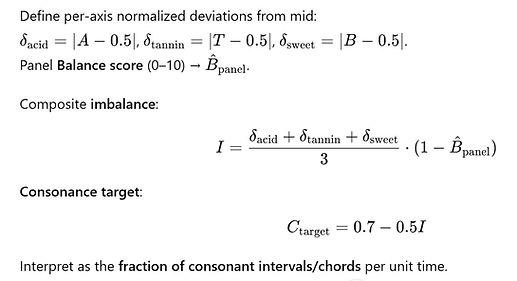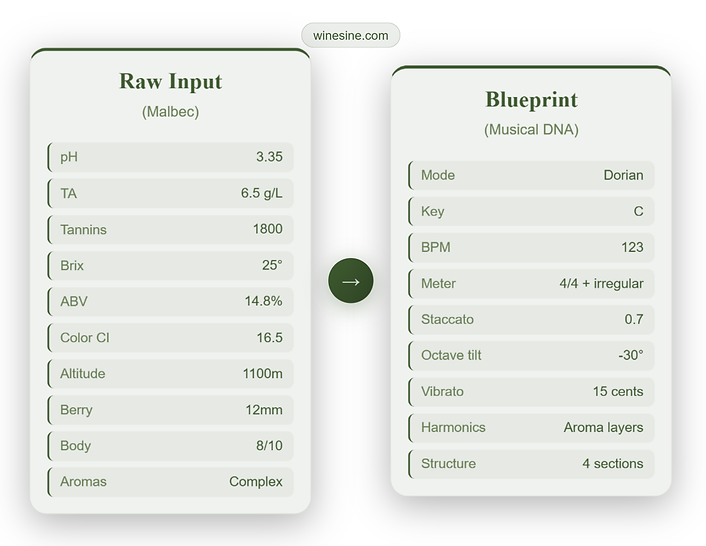Creating Musical DNA from Grapes
Every grape carries a hidden structure: sugars, acids, tannins, pigments, aromas, and textures. These physical and chemical features define how a wine will taste and feel. But what if we could hear them as well?
The Musical DNA of a grape is a blueprint that translates its measurable qualities into musical form.
-
Sugar and alcohol potential become tempo and macro-energy.
-
Acidity and freshness shape the register and brightness of pitch.
-
Tannins and texture influence rhythmic density and articulation.
-
Aroma layers unfold as harmonic overlays and timbral colors.
-
Balance and body determine form, motifs, and development over time.
The result is not a finished composition, but a deterministic musical skeleton — a blueprint that can be orchestrated with any instrument, processed in digital audio software, or interpreted by musicians.
Each grape variety thus has its own musical fingerprint. Malbec, Cabernet Franc, Gewürztraminer, or Zinfandel - each will always generate its own unique musical DNA, because the mappings are rooted in their chemical reality, not associations or arbitrary style.
From vineyard to waveform, from chemistry to melody: grapes can sing their structure.
Grape → Music System (Deterministic, Range-Aware, Non-associative)
0) Data Model & Normalization
0.1 Input schema (grape-centric; winemaking-neutral)

0.2 Normalization

1 Primary Identity Layer (highest weight)
1.1 Tonal world & register from acidity

1.2 Rhythm & articulation from tannins

1.3 Global tempo & macro-energy from sugar & potential alcohol

1.4 Orchestration mass & tessitura from anthocyanins (color intensity)

1.5 Timbre palette & motif micro-gestures from aroma families

2 Secondary Stylizers (medium weight)
2.1 Altitude, diurnal range, UV → space, register spread, modulation

2.2 Climate stability (rainfall CV) & MGST → meter and harmony temperature

2.3 Soil composition → spectral EQ & resonance set

2.4 Morphology (berry size, skin:pulp, seeds) → note density & low-mid texture

3 Form & Perceived Structure (form-shapers)
3.1 Body → polyphony & chord extension density

3.2 Finish length → phrase and cadence timing

3.3 Balance → consonance/dissonance quota

3.4 Flavor complexity (panel) → motif diversity

4 Conflict Resolution & Multi-mapping Rules

5 Hierarchical Weighting (with variance awareness)

6 Operational Recipe (Input → Output)



7 Example Mapping Snippets (deterministic)


8 Advanced (optional but precise)
8.1 Molecular hook (non-arbitrary)

8.2 Temporal viticultural curves
Grape → Music Blueprint
Grape to Music Blueprint is an interactive experiment that translates the hidden chemistry of wine grapes into musical blueprints.
Here you can:
-
Enter grape variety data (sugar, acidity, tannins, etc.) and generate a deterministic musical profile of its character.
-
Explore how grape attributes shape tempo, rhythm, harmonic layers, articulation (staccato, vibrato), and melodic flow.
-
Listen to a synthesized preview of the blueprint.
-
Save the blueprint (JSON format) for further exploration, orchestration, or creative use.
Each blueprint is a data-driven musical skeleton, not a final composition. Think of it as sheet music without the orchestra: Malbec will always produce its own blueprint, Cabernet Franc its own, etc.
You can take these blueprints and:
-
Import them into DAWs (Digital Audio Workstations) like Ableton Live, FL Studio, Logic Pro, Cubase.
-
Use them with notation software such as MuseScore, Sibelius, Finale.
-
Map parameters onto synths, samplers, or orchestral libraries (Kontakt, Spitfire, VST plugins).
-
Process them further with algorithmic music tools (Pure Data, Max/MSP, SuperCollider).
-
Or even transform them into MIDI scores for live instruments.
This way, grapes don’t just play a simple tune - they provide a framework of musical DNA that you can orchestrate into jazz, classical, electronic, or any genre you choose.
The raw input
Our Malbec example has a lot of numbers:
"chem": {"pH": 3.35, "TA_gL": 6.5, "tannins_mgL": 1800, ...} "aromas": {"terpenes":0.2, "pyrazines":0.1, ...} "geo": {"altitude_m":1100, "MGST_C":18, ...} "morph": {"berry_mm":12, "skin_pulp":0.28, ...} "sensory": {"body":8, "finish_sec":36, ...}
This is a giant table of grape features: chemistry, aromas, soil, climate, berry shape, and tasting scores. It’s precise, but not immediately usable for creating music or analyzing patterns.
Think of it as the raw ingredients in a recipe: you know the numbers, but you don’t yet know how to mix them into a meal.
The blueprint
The blueprint translates those numbers into various musical concepts, such as the following:
-
Mode → which musical scale to use (Ionian, Dorian, etc.)
-
Key center → the tonal anchor
-
BPM → how fast the music should play
-
Meter plan → time signature and rhythm complexity
-
Staccato / density / syncopation → how “choppy” or “dense” the notes are
-
Octave tilt → whether the melody is brighter or darker
-
Aroma layers → extra musical layers representing flavors/aromas
-
Form → structure of the musical sections (Appearance, Nose, Palate, Finish)
-
Space / reverbs / vibrato → gives depth and expressiveness
In other words, the blueprint is a map from grape features → actual music parameters.
Without the blueprint, you couldn’t just “play the grape” as music. With it, you have a ready-to-use musical score blueprint: tempo, scale, note patterns, dynamics, layers - all derived from the chemical, sensory, and geographic traits.
So in Malbec’s case, instead of juggling pH 3.35, tannins 1800, color intensity 16.5, you now have a musical DNA: Dorian mode, 120 BPM, 4/4 time with irregularities, aroma-inspired harmonics, and expressive form sections. That’s what you actually need to turn it into a rich musical track.
Below you may see a clear, visual ELI5-style diagram of how Malbec’s raw numbers become a musical blueprint.

You may notice the blueprint has fewer entries than the raw input. That’s not a mistake; it’s how translation works.
Raw input is redundant.
The grape dataset has overlaps: sugar (Brix) and alcohol (%ABV) both describe sweetness; pH and TA both describe acidity; body is already a synthesis of tannins, alcohol, and extract. The input list is “wide” but repetitive.
Blueprint is distilled.
It doesn’t mirror the input but maps it into music. pH + TA become a mode; sugar + ABV become tempo; tannins + body + color become density or register tilt. Several numbers collapse into one feature.
Why fewer entries?
Because the blueprint is compressed (merging values), musicalized (only expressed as tempo, mode, rhythm, articulation, etc.), and actionable (only what shapes sound is kept). In Malbec’s case, one “missing” value simply fused with another into a single musical decision.





